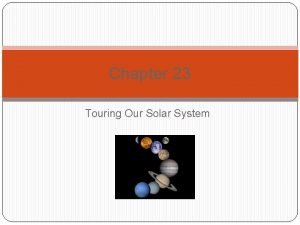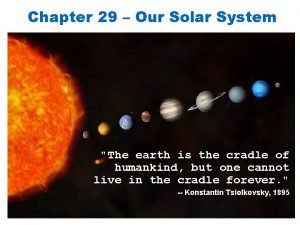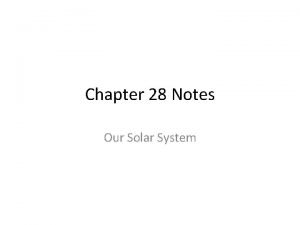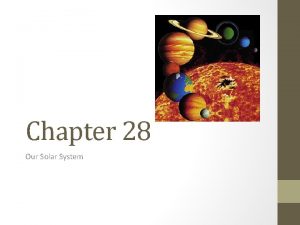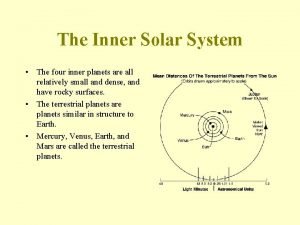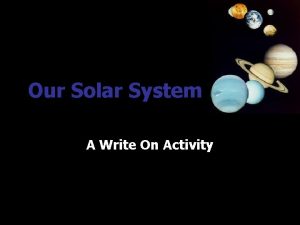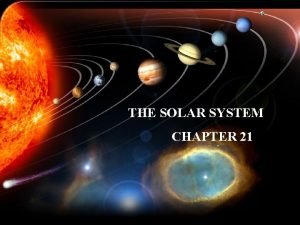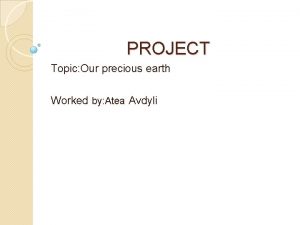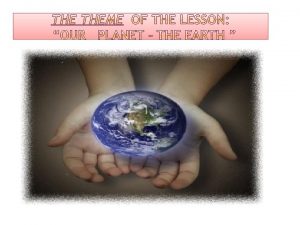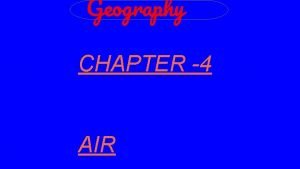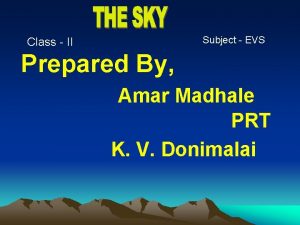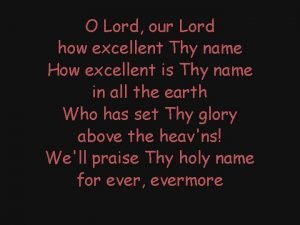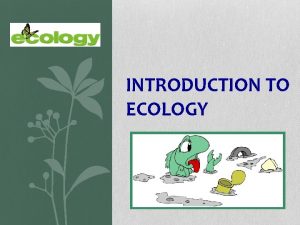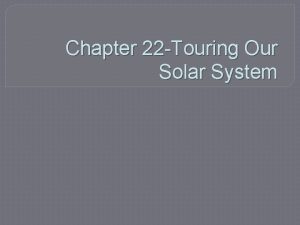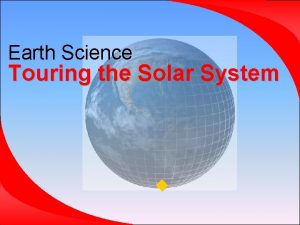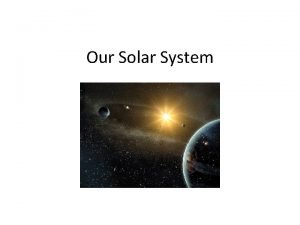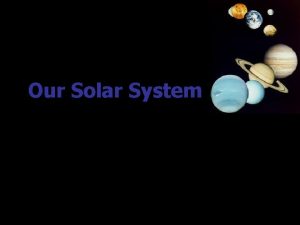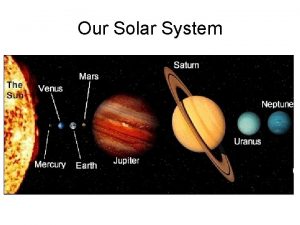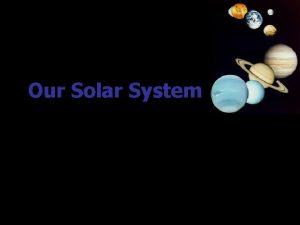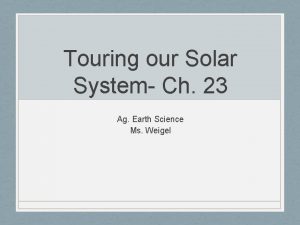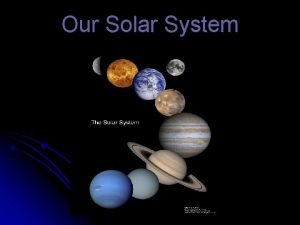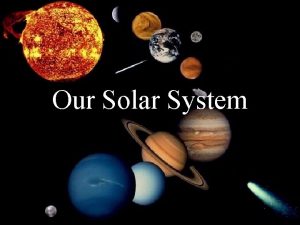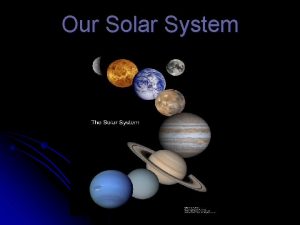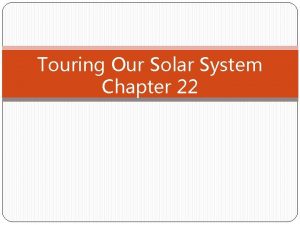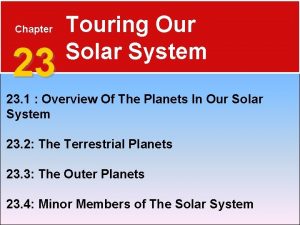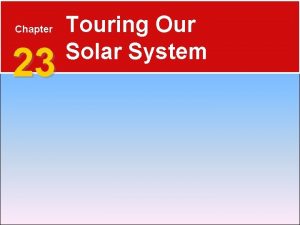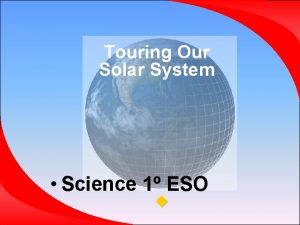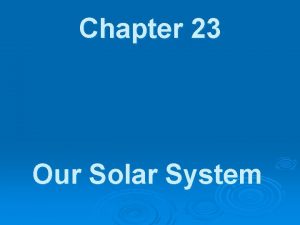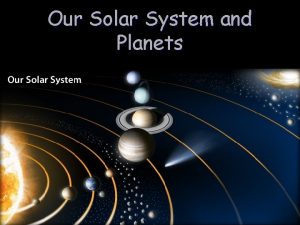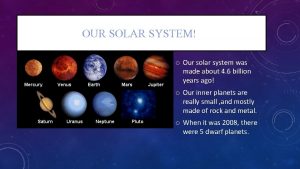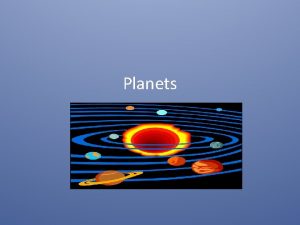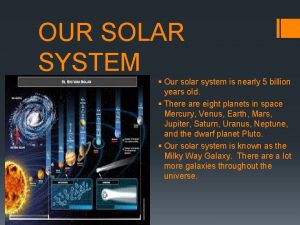Touring Our Solar System Chapter 23 Earth and































- Slides: 31

Touring Our Solar System Chapter 23 Earth and Space Science

23. 1 The Solar System • 99. 85 % of the mass of our solar system is contained within the ___ • The Planets make up 0. 15% of the mass. • Order of the planets: Mercury, Venus, Earth, Mars, Jupiter, Saturn, Uranus, and Neptune.

23. 1 The Solar System • All the planets orbit the sun in ________ • All travel in the same direction • The planets are split into two groups – the _______ and the _______ planets. • Size is the most obvious difference between the two groups. • Density, chemical makeup, and rate of rotation are other ways in which the two groups differ.

23. 1 The Solar System • Pg. 646, figure 2 • Interiors of the Planets • 3 groups: _________ • Gases: Hydrogen and Helium • Rocks: iron and silicate minerals • Ices: ammonia, methane, carbon dioxide, water. • The terrestrial planets are mostly rocky, little gas, the outer planets are mostly gas.

23. 1 The Solar System • Atmospheres of the Planets • __________ – thick atmospheres – hydrogen, helium, methane, ammonia • __________ – meager atmospheres - lighter gases • In order for a planet to have an atmosphere it must have enough gravitational pull to keep the gas molecules from reaching the _________________

23. 1 The Solar System • Formation of the Solar System • ________– a cloud of dust and gas in space • Usually consists of 92% H, 7% He, and less than 1% all other gases. • These nebula start to rotate and contract, then speed up

23. 1 The Solar System • _____________ – the sun and planets formed from a rotating disk of dust and gases. • As it sped up, the center flattened out, matter condensed, and the sun was formed • Pg. 647, figure 3

23. 1 The Solar System • _____________ – small irregularly shaped bodies that formed from solid bits of matter that collided in space. • As the collisions continued the planetesimals got bigger, and more gravity attracted more matter and they grew into planets.

23. 1 The Solar System • Inner planets were too close to the sun for the ices to solidify – therefore they were formed from materials with high melting points. • For the outer planets, they were cold enough for ices of water and other substances to form. Both solid materials and gases.

23. 2 The Terrestrial Planets • The four inner-most planets are called the terrestrial planets because they are made of rock. • _______, _______, and ________.

23. 2 The Terrestrial Planets • _______: The Innermost Planet • Smallest planet – hardly larger than Earth’s moon • No atmosphere • Cratered highlands and smooth terrain • 1 rotation = ______ Earth days • Nighttime temps = -173ôC • Noontime temps = 427 ôC • Has the greatest temp extremes of any planet

23. 2 The Terrestrial Planets • ________: The Veiled Planet • 2 nd in brilliance to the ____ in the night sky. • Revolution = ______ Earth-days • Called “_________” – similar in size, density, mass, and location in solar system • Covered with thick clouds – hard to see surface

23. 2 The Terrestrial Planets • ______ spacecraft reached the surface and gave us our main information. • Basaltic volcanism • Tectonic activity • 80% covered by lava flows • 8% highlands • ______________– temp 475ôC • 97% CO 2 in atmosphere

23. 2 The Terrestrial Planets ______: The Red Planet • Atmosphere: 1% the density of Earth’s. • Mostly _____ • Polar caps – mostly of water and CO 2 • Has dust storms and hurricane-force winds up to 270 km/hr. • Very cold – thin atmosphere

23. 2 The Terrestrial Planets • Mars’ surface features • ___________ (1971) • Large, inactive volcanoes • Largest – ___________ • Size of Ohio, 23 km high • Cratered • Large canyons – larger than the Grand Canyon • Largest – ____________

23. 2 The Terrestrial Planets • Water on Mars? • Drainage patterns similar to Earth • Opportunity – evaporite minerals, geologic formations assoc. with water • Viking – ancient islands • Mars Global Surveyor – groundwater • Temp range: -70ôC to -100ôC

23. 3 The Outer Planets (and Pluto) • __________: Giant Among Planets • 1/800 the mass of the sun • 2. 5 more massive than all the other planets and moons. • Quickest rotation: 10 -Earth hours • ___________- cyclonic storm • Not made up entirely of gas • Liquid hydrogen, liquid metallic hydrogen, • Rocky, metallic core

23. 3 The Outer Planets (and Pluto) • Hydrogen-helium atmosphere • Wind system that generated light and dark colored bands. • Jupiter’s moons – 63 • 4 largest – _____, ________________, _______ • Discovered by Galileo in 1610 • Io is volcanically active

23. 3 The Outer Planets (and Pluto) • Jupiter’s Rings • Discovered by Voyager I - fine, dark particles

23. 3 The Outer Planets (and Pluto) • ________: The Elegant Planet • 29. 46 Earth-years to make one revolution • Extensive ring system • Discovered by Galileo in 1610. • Visited by Voyager I & II in 1980 and 1981

23. 3 The Outer Planets (and Pluto) • • • Winds up to 1500 km/hr Cyclonic storms within the atmosphere Discovered 11 additional moons Rings were very complex Has 56 moons Largest – ________ – has an atmosphere of its own

23. 3 The Outer Planets (and Pluto) • Enceladas – volcanically active • Liquid water geysers • Saturn’s Rings • made of _________ • 2 categories, based on particle density

23. 3 The Outer Planets (and Pluto) • _______: The Sideways Planet • Rotates on its side • Has a ring system • 13 moons • Largest is __________ • Winds exceeding 1000 km/hr • _______________ • Cirrus-like clouds - methane

23. 3 The Outer Planets (and Pluto) • _________: Dwarf Planet • Has not cleared the area around its orbit, therefore, it is not a planet • Many other dwarf planets occur, some larger than Pluto, some smaller • Has a moon, Charon

23. 4 Minor Members of the Solar System • In February 2001, The NEAR Shoemaker made history by becoming the first spacecraft to land on the asteroid, Eros. • _____________ – small, rocky bodies that orbit the sun. • They are larger than 10 meters in dia. • Most lie in the __________ between Mars and Jupiter.

23. 4 Minor Members of the Solar System • Asteroids are irregularly shaped • Scientists believe they are fragments of a previous planet that was destroyed. • ___________ – pieces of rocky and metallic minerals held together by frozen water, ammonia, methane, carbon dioxide, carbon monoxide.

23. 4 Minor Members of the Solar System • Take hundreds of thousands of years to complete a single orbit around the sun. • _________ – head of the comet • Has a nucleus • As comets approach the sun they develop a tail that extends behind as gases are evaporated

23. 4 Minor Members of the Solar System • _________ contains comets with a short orbital period. • Located beyond ________ • They lie roughly in the same plane as the planets • __________ – contains comets with a long orbital period. • Do not lie in the same plane as the planets

23. 4 Minor Members of the Solar System • _____________ – orbital period of 76 years. • was here in 1910 and 1986 • Will return in 2061 • ____________ – small, solid particle that travels through space.

23. 4 Minor Members of the Solar System • Originate in one of three areas • 1. interplanetary debris • 2. material from the asteroid belt • 3. the solid remains of comets that once traveled near Earth’s orbit • __________ - meteoroids that enter the Earth’s atmosphere

23. 4 Minor Members of the Solar System • ___________ – 60 or more meteors seen in an hour • Perseid meteor shower – around Aug. 12 th each year • _____________ – a meteoroid that actually reaches the Earth. • Meteor Crater in Arizona –
 Chapter 23 touring our solar system
Chapter 23 touring our solar system Verkeersinfo aalst
Verkeersinfo aalst Chapter 29 our solar system
Chapter 29 our solar system Chapter 28 our solar system
Chapter 28 our solar system Chapter 28 our solar system
Chapter 28 our solar system What are the four inner planets
What are the four inner planets What is the 2nd smallest planet in our solar system
What is the 2nd smallest planet in our solar system Biggest planet in our solar system
Biggest planet in our solar system Write about our solar system
Write about our solar system Whole sale solar
Whole sale solar Inexhaustible source of energy
Inexhaustible source of energy Our awareness of ourselves and our environment
Our awareness of ourselves and our environment Awareness of ourselves and our environment is
Awareness of ourselves and our environment is Our awareness of ourselves and our environment
Our awareness of ourselves and our environment Our awareness of ourselves and our environment
Our awareness of ourselves and our environment Http://www.nineplanets.org
Http://www.nineplanets.org Thinking affects our language which then affects our
Thinking affects our language which then affects our Our census our future
Our census our future Christ, be our light shine in our hearts
Christ, be our light shine in our hearts Marcus aurelius our life is what our thoughts make it
Marcus aurelius our life is what our thoughts make it We bow our hearts
We bow our hearts Our census our future
Our census our future Our life is what our thoughts make it
Our life is what our thoughts make it Money madness was published in the collection
Money madness was published in the collection God our father christ our brother
God our father christ our brother Our future is in our hands quotes
Our future is in our hands quotes Our precious earth
Our precious earth The earth is my home i promise to keep it song download
The earth is my home i promise to keep it song download Our earth is surrounded by a huge blanket of *
Our earth is surrounded by a huge blanket of * Our earth class 2 ppt
Our earth class 2 ppt O lord how excellent is thy name
O lord how excellent is thy name This insulates our earth from the deep cold of space
This insulates our earth from the deep cold of space
